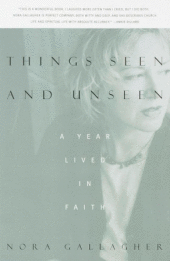Book Notes
 Nora Gallagher, Things Seen and Unseen; A Year Lived in Faith (New York: Vintage, 1998), 241pp.
Nora Gallagher, Things Seen and Unseen; A Year Lived in Faith (New York: Vintage, 1998), 241pp.
"Sometimes I just can't stand church life," confessed Nora Gallagher to her friend Ann on the next-to-the-last page of her memoir. Baptized at the age of 15, she dropped out of church for about a decade, returned in her late twenties, then spent two decades negotiating a lover's quarrel with church life that she describes as both "familiar and a foreign planet. To cope we are often ambivalent." I suspect that a large part of this best-seller's success has been Gallagher's candor and the chord it has struck with readers who resonate with her experience.
Gallagher came to Trinity Episcopal Church in Santa Barbara as a "tourist," she says, but narrates how five years later, much to her surprise, she discovered that she had stayed on as a "pilgrim." Trinity was struggling in many ways for many reasons. The sanctuary that held 400 people was three-quarters empty. Dysfunctions abounded. But a new interim pastor, Mark, heralded a new day and the ship began to turn around. Gallagher organizes her eight chapters according to the church liturgical year (much as Kathleen Norris did for her monastic year in Cloister Walk)—Advent, Christmas, Epiphany, Lent, Holy Week, Eastertide, Pentecost, and Ordinary Time, and pulls back the curtain on every day church life at Trinity among ordinary people. She steps forward as a lay minister, serves communion, participates in a base community, and works at the church soup kitchen. She visits the dying, learns to love Republicans, attends meetings, and eats many a tuna casserole.
At its best, she discovered, church can be a place where, as her friend put it, "you can bring your whole self." Like her brother's bladder cancer, her non-believing husband, the drug death of Ephraim (one of their homeless regulars), or their pastor's announcement that he was gay and how Trinity handled that explosive issue. Gallagher shows what it looks like to do your doubting inside the church, rather than taking pot shots from the outside. She describes a very imperfect human institution where honest people articulate genuine questions and differing opinions. In such a church, observed the English historian Esther de Waal, we encounter the "sense of allowing the extraordinary to break in on the ordinary" (p. 18). If that prospect sounds attractive to you, then read Things Seen and Unseen. Then do what I did; read her sequel called Practicing Resurrection (2003).
Dan Clendenin: dan@journeywithjesus.net


